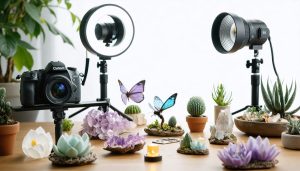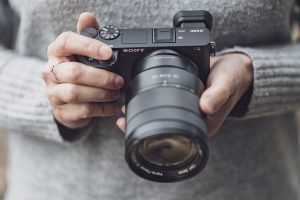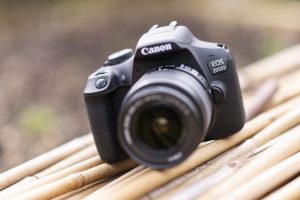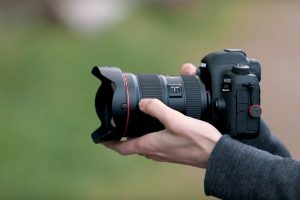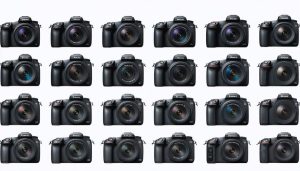
Transform your macro photography from shaky to stunning with a professional-grade macro stand – the unsung hero behind breathtaking close-up images. While mastering macro photography techniques is essential, even the steadiest hands can’t match the precision of a dedicated support system. Modern macro stands combine stability with precise adjustments, enabling photographers to capture intricate details of subjects ranging from delicate flower stamens to microscopic textures. Whether you’re shooting with a DSLR, mirrorless camera, or smartphone, the right macro stand eliminates vibration, maintains consistent focusing distances, and provides the exact positioning control needed for professional-quality close-up work. By integrating features like fine-focus rails, adjustable arms, and vibration dampening, these specialized tools transform challenging macro shots into repeatable, professional results.
Why You Need a Dedicated Macro Photography Stand
Stability Requirements for Macro Work
When working with high magnifications in macro photography fundamentals, even the slightest movement can ruin your shot. At 1:1 magnification, a vibration of just 1mm appears as a full millimeter in your final image, making stability absolutely crucial for sharp results.
Think of it this way: when photographing a tiny insect, even your breathing or the subtle vibration from nearby traffic can cause noticeable blur. This is why professional macro photographers prioritize rock-solid support systems. The higher your magnification, the more critical stability becomes – especially when shooting between 2x and 5x life-size.
Your macro stand needs to provide stability in multiple directions. Vertical stability prevents unwanted bounce in your camera setup, while horizontal stability stops lateral drift that can throw off your precise focusing. The base should be heavy enough to dampen vibrations and wide enough to prevent tipping, particularly when using longer macro lenses or extension tubes.
For optimal results, look for stands with vibration-dampening materials and adjustable legs that can compensate for uneven surfaces. Remember, stability isn’t just about the stand – it’s about creating a complete system that works together to keep your macro subjects tack-sharp.
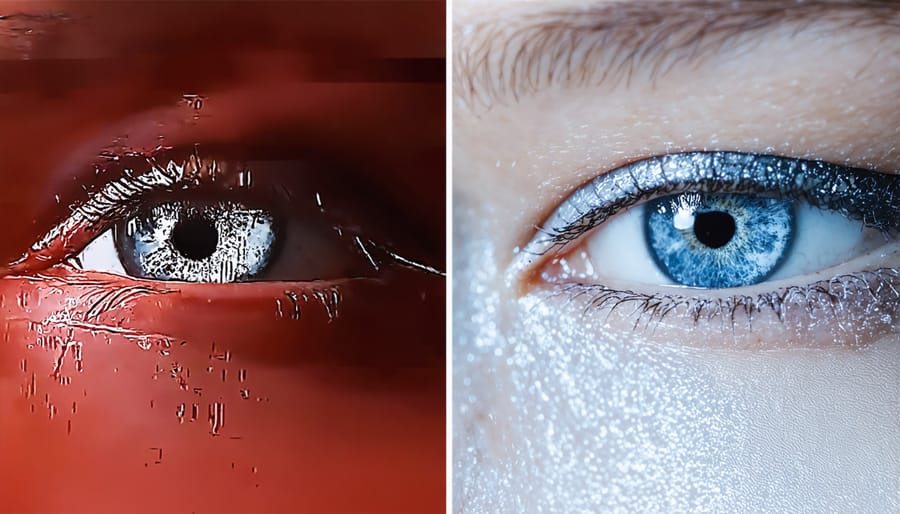
Focus Stacking Benefits
A stable macro photography stand opens up fascinating possibilities for advanced focus stacking techniques, allowing you to capture incredibly detailed images with edge-to-edge sharpness. When photographing tiny subjects, even the slightest camera movement can affect focus, making handheld stacking nearly impossible.
With a reliable stand, you can precisely adjust your camera’s position in microscopic increments, ensuring each shot in your focus stack is perfectly aligned. This consistency is crucial when photographing insects, flowers, or jewelry, where every detail matters. The stand’s stability eliminates camera shake and maintains exact positioning throughout the sequence.
Many photographers find that using a macro stand dramatically improves their success rate with complex stacking projects. Instead of wrestling with handheld shots, you can concentrate on perfecting your composition and lighting. The stand’s precise height adjustment and angle controls also make it easier to experiment with different perspectives while maintaining perfect focus throughout your stack.
Whether you’re capturing dewdrops on a spider’s web or the intricate patterns on a butterfly’s wing, a quality macro stand transforms challenging shots into achievable goals.
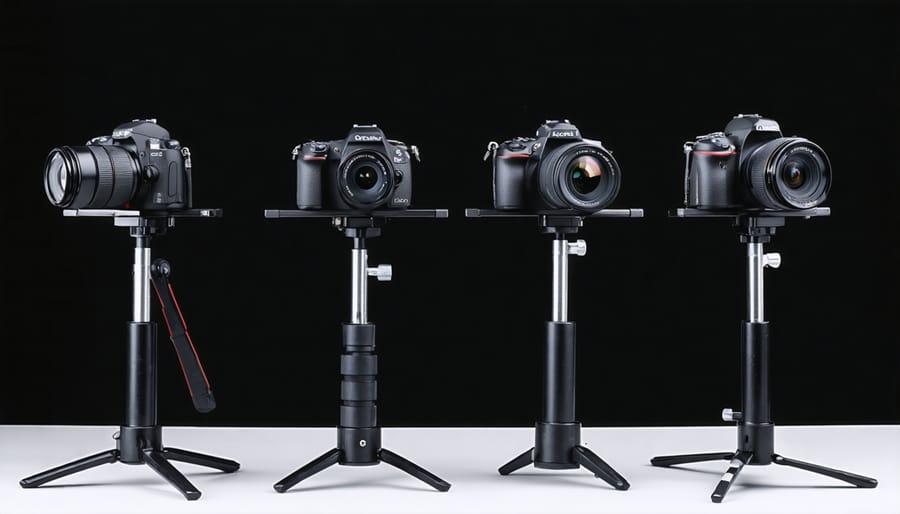
Types of Macro Photography Stands
Focusing Rails and Stands
Precise focusing is crucial in macro photography, where even the slightest movement can throw your subject out of focus. Modern macro photography stands typically incorporate dual-axis fine focusing rails, allowing for minute adjustments in both horizontal and vertical directions. These rails usually feature precision-engineered rack-and-pinion mechanisms with graduated markings, enabling photographers to make repeatable adjustments down to fractions of a millimeter.
Most professional-grade focusing rails include lockable positions and smooth-operating knobs that prevent unwanted movement during shooting. Some advanced models feature geared heads with micrometer adjustments, particularly useful when working with magnification ratios greater than 1:1. These precision tools are essential when focus stacking, where multiple images at slightly different focus points are combined for enhanced depth of field.
The stand’s stability is equally important as its focusing capability. Look for models with robust locking mechanisms and vibration-dampening features. Some photographers enhance stability by adding counterweights or additional support bars. When selecting a focusing system, consider the weight of your camera setup – heavier medium format systems require more robust rails than lighter mirrorless configurations. Remember that the most expensive option isn’t always necessary; choose based on your specific shooting needs and typical subjects.
Copy Stands
Copy stands, originally designed for document reproduction, have become invaluable tools in macro photography. These versatile platforms consist of a flat base and a vertical column with an adjustable camera mount, offering exceptional stability and precise positioning control.
The primary advantage of using a copy stand for macro work lies in its ability to maintain perfect parallel alignment between the camera and subject. This is crucial when photographing small, flat objects like coins, stamps, or botanical specimens, where maintaining consistent focus across the entire frame is essential.
Most copy stands feature built-in lighting options, typically with adjustable lamps on either side of the base. This controlled lighting setup eliminates shadows and ensures even illumination across your subject, which is particularly important when documenting scientific specimens or creating product photographs.
The ability to make minute adjustments to camera height using the geared column mechanism is another significant benefit. This precise control allows photographers to achieve exact magnification ratios and maintain consistent framing across multiple shots. Many professional copy stands also include a focusing rail system, enabling fine-tuned adjustments without disturbing the camera’s position.
While traditionally associated with commercial and scientific photography, copy stands are increasingly popular among macro enthusiasts for their reliability and precision.
Custom-Built Solutions
For photographers who enjoy hands-on projects, building a custom macro photography stand can be both rewarding and cost-effective. Many photographers start with a basic copy stand or microscope base and modify it to suit their specific needs. Popular DIY solutions include using PVC pipes to create a flexible positioning system, or repurposing heavy-duty microphone stands with custom mounting brackets.
A common custom modification involves adding a horizontal arm to a vertical stand, creating an overhead setup perfect for flat-lay photography. Some photographers integrate LED strip lighting into their builds, while others add counterweights for better balance when using heavier equipment.
One creative approach is to combine a sturdy base plate with articulating arms from document cameras or desk lamps. These can be reinforced and modified to hold camera gear securely. For precise control, many photographers incorporate rack-and-pinion focusing rails from old enlargers or microscopes into their builds.
Remember to prioritize stability in your custom setup – even minor vibrations can ruin a macro shot. Using materials like steel or aluminum rather than plastic for critical components will ensure better results.
Setting Up Your Macro Stand
Optimal Positioning
Achieving crisp, sharp macro images starts with proper stand positioning. Begin by ensuring your work surface is completely stable and level. Even minor vibrations can affect image quality at high magnifications, so consider placing your setup on a solid table away from foot traffic or household machinery.
Position your subject at the center of the stand’s base plate, allowing enough surrounding space for adjustments. The optimal working distance typically falls between 4-8 inches from your lens to the subject, depending on your specific macro lens and desired magnification ratio.
Lighting plays a crucial role in positioning. Arrange your stand so that natural light falls evenly across your subject, or position your artificial lighting equipment with enough clearance to prevent shadows from the stand’s structure. For transparent or reflective subjects, consider positioning the stand at a slight angle to minimize unwanted reflections.
When using rail slides or adjustment knobs, make incremental movements rather than dramatic shifts. This methodical approach helps maintain focus and composition. Remember that at macro magnifications, even a millimeter’s movement can significantly impact your final image.
For stability-critical shots, position your camera’s center of gravity directly over the stand’s vertical support. This alignment minimizes torque and reduces the risk of subtle movements during longer exposures.
Vibration Control
Vibration control is crucial in macro photography, where even the slightest movement can ruin your shot. When working at high magnifications, vibrations from sources like camera shake, wind, or even nearby traffic can significantly impact image sharpness. The good news is that your macro photography stand can help minimize these issues when properly set up.
Start by ensuring your stand’s base is as stable as possible. Place it on a solid surface, preferably on a concrete floor rather than wooden floorboards that can transmit vibrations. Many photographers add weight to their stand’s base using sandbags or a heavy platform to increase stability.
Consider using vibration-dampening materials like rubber feet or foam pads under your stand’s contact points. These materials help absorb and dissipate unwanted movements before they reach your camera. If you’re shooting outdoors, a windbreak can protect your setup from sudden gusts that might cause movement.
When mounting your camera, always use the stand’s locking mechanisms firmly but avoid overtightening, which can create stress points. If your stand has a focusing rail, ensure all adjustment knobs are properly tightened after composition. For critical work, consider using a remote shutter release or your camera’s self-timer to eliminate vibration from pressing the shutter button.
These preventive measures might seem excessive, but they make a noticeable difference in the final image quality, especially when shooting at high magnifications where every detail counts.
Essential Accessories
Lighting Solutions
Proper lighting is crucial for successful macro photography, and your stand setup should accommodate various lighting solutions. A well-planned macro lighting setup can make the difference between a mediocre shot and a stunning image.
Ring lights are particularly effective with macro stands, as they provide even illumination around your subject without casting unwanted shadows. Most quality stands feature mounting points for ring lights, making them an ideal starting point for beginners.
For more advanced setups, consider incorporating LED panel lights or flexible arm lights that can be positioned precisely where needed. Many photographers combine multiple light sources – for instance, using a ring light for primary illumination while adding accent lighting with small LED panels mounted on articulating arms.
Flash options are equally important. While built-in camera flash rarely works well for macro work, dedicated macro flash units can be mounted to your stand’s accessory points. Look for stands with multiple ¼-inch threading points or cold shoe mounts to accommodate various lighting accessories.
Don’t overlook the value of diffusion materials. Your stand should have enough clearance to allow for softboxes, diffusion panels, or even DIY solutions like white paper diffusers. These help soften harsh light and reduce unwanted reflections, especially when photographing shiny subjects like insects or jewelry.
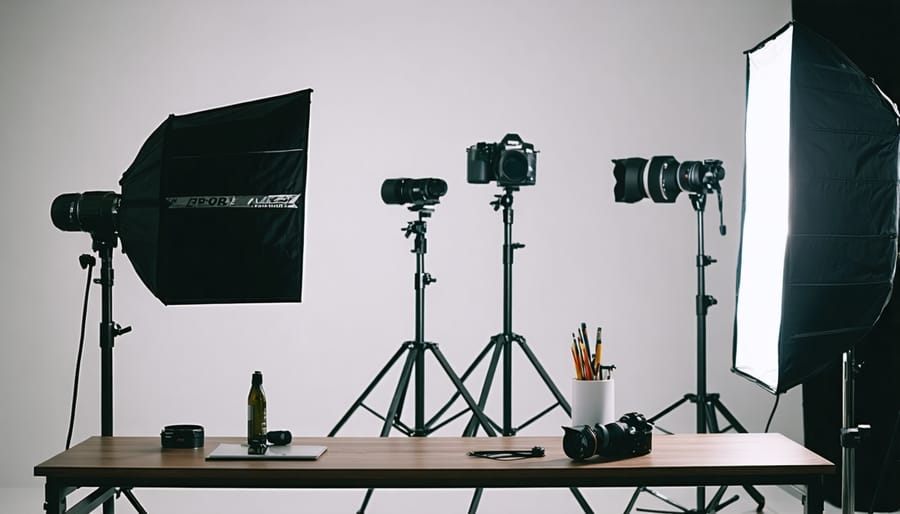
Support Accessories
To maximize the potential of your macro photography stand, several essential accessories can significantly enhance your shooting capabilities. A focusing rail is perhaps the most valuable addition, allowing precise forward and backward adjustments for perfect focus stacking. These rails come in both manual and motorized versions, with the latter offering automated micro-adjustments for ultra-precise work.
Lighting accessories are equally crucial. LED ring lights or macro flash units can mount directly to your stand, providing even illumination for your subjects. Consider adding diffusers or reflectors to soften harsh shadows and create more pleasing lighting conditions.
Anti-vibration pads or weights can help stabilize your setup, particularly crucial when working at high magnifications where even the slightest movement can blur your image. Some photographers also incorporate bubble levels to ensure their stand remains perfectly horizontal, especially important when photographing reflective subjects or water droplets.
For those working with living subjects like insects or flowers, various clamps and holders can keep specimens steady without causing damage. Articulating arms with small clips are particularly useful for positioning small props or additional lights around your subject.
Don’t overlook the importance of a quality cable release or remote trigger to minimize camera shake. When combined with mirror lock-up functionality, these accessories help ensure the sharpest possible images, even at extreme magnifications.
A reliable macro photography stand is an indispensable tool for achieving stunning close-up images. Throughout this guide, we’ve explored the various types of stands available, from simple tabletop options to professional-grade focusing rails and specialized macro stands. The key takeaway is that your choice should align with both your shooting needs and skill level.
For beginners, we recommend starting with a sturdy tabletop stand that includes basic positioning features. As your expertise grows, consider upgrading to a more sophisticated system with precise focusing controls and multiple adjustment points. Remember that stability is paramount in macro photography – even the slightest movement can affect your final image quality.
When selecting your stand, prioritize build quality and stability over fancy features. Consider factors like maximum load capacity, adjustment flexibility, and compatibility with your existing equipment. Don’t forget about additional accessories like lighting mounts and anti-vibration features that can enhance your macro photography setup.
Regular maintenance of your stand will ensure its longevity and consistent performance. Store it in a clean, dry environment and periodically check all moving parts and locking mechanisms. Whether you’re photographing flowers, insects, or small objects, the right macro stand will help you capture those minute details with remarkable clarity and precision.
By investing in quality equipment and practicing proper technique, you’ll be well-equipped to explore the fascinating world of macro photography with confidence and creativity.





